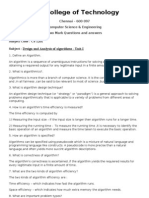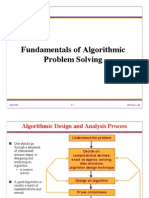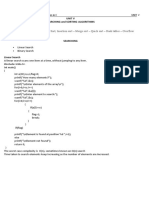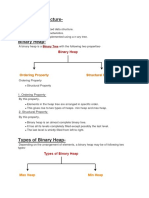0 ratings0% found this document useful (0 votes)
525 viewsData Structure - Bubble Sort Algorithm
Bubble sort is a simple sorting algorithm that compares adjacent elements and swaps them if out of order. It repeats this process until the list is fully sorted, but is not efficient for large data sets due to its quadratic time complexity. The algorithm can be improved by adding a flag to stop iterating once no swaps occur, and restricting comparisons to unsorted portions of the list after each pass.
Uploaded by
Lea LovatoCopyright
© © All Rights Reserved
Available Formats
Download as PPTX, PDF, TXT or read online on Scribd
0 ratings0% found this document useful (0 votes)
525 viewsData Structure - Bubble Sort Algorithm
Bubble sort is a simple sorting algorithm that compares adjacent elements and swaps them if out of order. It repeats this process until the list is fully sorted, but is not efficient for large data sets due to its quadratic time complexity. The algorithm can be improved by adding a flag to stop iterating once no swaps occur, and restricting comparisons to unsorted portions of the list after each pass.
Uploaded by
Lea LovatoCopyright
© © All Rights Reserved
Available Formats
Download as PPTX, PDF, TXT or read online on Scribd
You are on page 1/ 8
Data Structure - Bubble Sort Algorithm
Bubble sort is a simple sorting algorithm.
This sorting algorithm is comparison-based
algorithm in which each pair of adjacent elements is
compared and the elements are swapped if they
are not in order.
This algorithm is not suitable for large data sets as
its average and worst case complexity are of Ο(n2)
where n is the number of items.
How Bubble Sort Works?
Algorithm
Pseudocode
We observe in algorithm that Bubble Sort compares
each pair of array element unless the whole array
is completely sorted in an ascending order.
This may cause a few complexity issues like what if
the array needs no more swapping as all the
elements are already ascending.
To ease-out the issue, we use one flag
variable swapped which will help us see if any
swap has happened or not.
If no swap has occurred, i.e. the array requires no
more processing to be sorted, it will come out of the
loop.
Implementation
One more issue we did not address in our original
algorithm and its improvised pseudocode, is that,
after every iteration the highest values settles down
at the end of the array.
Hence, the next iteration need not include already
sorted elements.
For this purpose, in our implementation, we restrict
the inner loop to avoid already sorted values.
You might also like
- Introduction To The Design and Analysis of Algorithms - Lecture Notes, Study Material and Important Questions, AnswersNo ratings yetIntroduction To The Design and Analysis of Algorithms - Lecture Notes, Study Material and Important Questions, Answers16 pages
- 16 String Matching - Naive String Algorithm100% (1)16 String Matching - Naive String Algorithm9 pages
- Design and Analysis of Algorithm Lab (BSCS2351) Lab ManualNo ratings yetDesign and Analysis of Algorithm Lab (BSCS2351) Lab Manual46 pages
- Module-1: Review Questions: Automata Theory and Computability - 15CS54No ratings yetModule-1: Review Questions: Automata Theory and Computability - 15CS544 pages
- ADA IMP Questions With Solution For GTUNo ratings yetADA IMP Questions With Solution For GTU63 pages
- Unit-1 DAA Notes - Daa Unit 1 Note Unit-1 DAA Notes - Daa Unit 1 NoteNo ratings yetUnit-1 DAA Notes - Daa Unit 1 Note Unit-1 DAA Notes - Daa Unit 1 Note26 pages
- Fundamentals of Algorithmic Problem Solving: B.B. Karki, LSU 2.1 CSC 3102No ratings yetFundamentals of Algorithmic Problem Solving: B.B. Karki, LSU 2.1 CSC 31024 pages
- Computer Algoritham For Chennai Univarsity Unit5No ratings yetComputer Algoritham For Chennai Univarsity Unit511 pages
- Data Structure Unit 5 (Searching and Sorting Notes)No ratings yetData Structure Unit 5 (Searching and Sorting Notes)26 pages
- Cs 6402 Design and Analysis of AlgorithmsNo ratings yetCs 6402 Design and Analysis of Algorithms112 pages
- Algo - Mod12 - NP-Hard and NP-Complete ProblemsNo ratings yetAlgo - Mod12 - NP-Hard and NP-Complete Problems56 pages
- Levitin: Introduction To The Design and Analysis of AlgorithmsNo ratings yetLevitin: Introduction To The Design and Analysis of Algorithms35 pages
- Unit 3 Storage Strategies Indices B-Trees HashingNo ratings yetUnit 3 Storage Strategies Indices B-Trees Hashing12 pages
- Aim: To Implement First Pass of Two Pass Assembler For IBM 360/370 Objective: Develop A Program To Implement First PassNo ratings yetAim: To Implement First Pass of Two Pass Assembler For IBM 360/370 Objective: Develop A Program To Implement First Pass4 pages
- Brute Force: Design and Analysis of Algorithms - Chapter 3 1No ratings yetBrute Force: Design and Analysis of Algorithms - Chapter 3 118 pages
- Subsets, Graph Coloring, Hamiltonian Cycles, Knapsack Problem. Traveling Salesperson ProblemNo ratings yetSubsets, Graph Coloring, Hamiltonian Cycles, Knapsack Problem. Traveling Salesperson Problem22 pages
- Assignment (ANALYSIS AND DESIGN OF ALGORITHMS)100% (1)Assignment (ANALYSIS AND DESIGN OF ALGORITHMS)2 pages
- Data Structures and Algorithms Bubble SortNo ratings yetData Structures and Algorithms Bubble Sort3 pages
- For Introduction/Beginning of A ParagraphNo ratings yetFor Introduction/Beginning of A Paragraph67 pages
- Reported Speech: Orders AND Requests - Introducing Verbs: Order, Tell, AskNo ratings yetReported Speech: Orders AND Requests - Introducing Verbs: Order, Tell, Ask3 pages
- Grammar Revision Present Past Future Tenses Questi Fun Activities Games Grammar Drills 37114No ratings yetGrammar Revision Present Past Future Tenses Questi Fun Activities Games Grammar Drills 371143 pages
- A-Teens Race For Action and Fun With FOOD This MERDEKA!: Cup of Tea!No ratings yetA-Teens Race For Action and Fun With FOOD This MERDEKA!: Cup of Tea!2 pages



































































